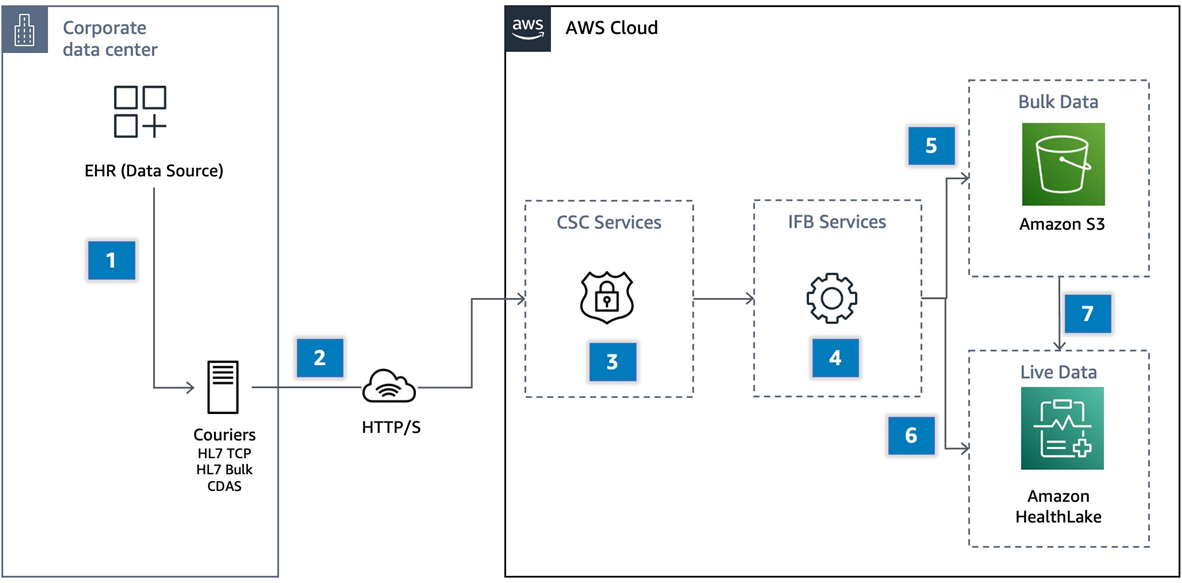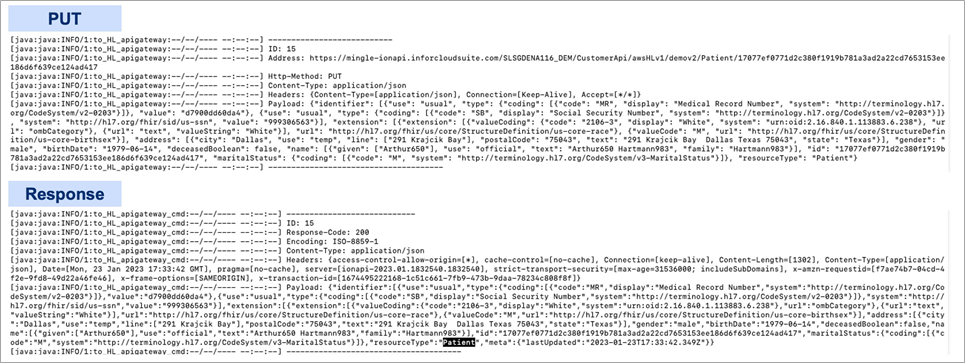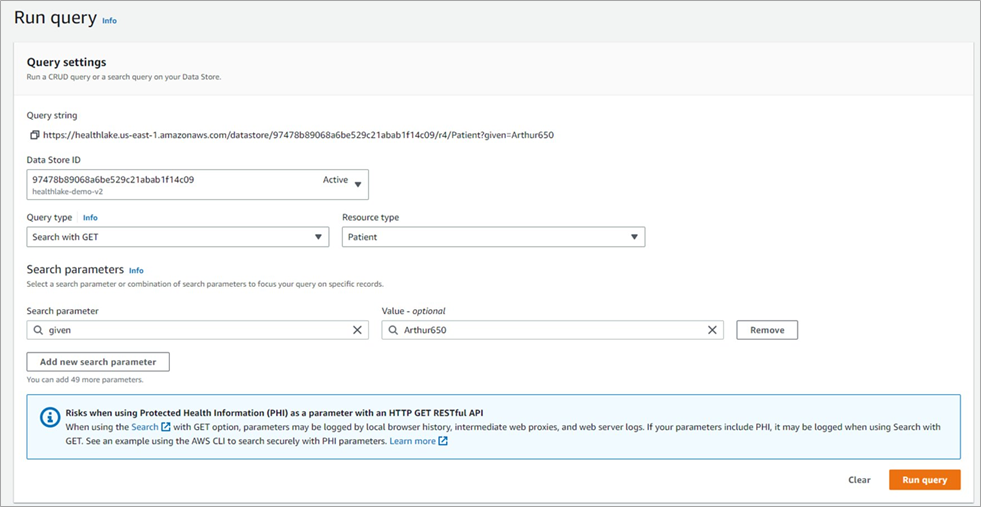AWS Partner Network (APN) Blog
Simplify Population Health Data Analysis with Infor FHIR On Ramp
By Yogesh Dhimate, Sr. Partner Solutions Architect – AWS
By Brian Warwick, Principal Partner Solutions Architect – AWS
By Bakha Nurzhanov, Interoperability Architect – AWS
By Joerg Schwarz, Industry Strategy & Solutions, Healthcare Interoperability – Infor
 |
| Infor |
 |
Population health is a key focus of public health research because it allows healthcare professionals and policymakers to identify and address health issues impacting large communities.
However, a common challenge in this work is that healthcare data is often stored in various electronic health record (EHR) systems, in various formats, and across disparate locations. Along with that, the data must be joined with other disparate datasets such as social determinants of health (SDOH) to better understand the impact of the datasets on health outcomes.
By providing tools for data integration, data management, and data interoperability, the Infor Cloverleaf platform is designed to help organizations improve the quality of care and reduce costs. Cloverleaf integrates and manages data from multiple sources by securely connecting to data at its source, converting it to common formats, and streaming the data from a source and destination of your choosing.
In this post, you will learn how Infor FHIR On Ramp (IFOR) enables customers to leverage the capabilities of Amazon HealthLake with any healthcare data source. IFOR is a new product in the Cloverleaf platform that provides seamless connectivity with Amazon HealthLake. This allows organizations to access and manage data from different sources, without the need for manual data entry or reconciliation.
Infor is an AWS Partner and AWS Marketplace Seller that builds cloud-based and industry-specific software. Infor holds several AWS Competencies, including the Healthcare ISV Competency.
About Amazon HealthLake
Amazon HealthLake is a HIPAA-eligible service offered on Amazon Web Services (AWS) that allows organizations to store, analyze, and share large amounts of health data. The service provides tools for analyzing data from EHRs, claims data, genomics data, and other sources.
Amazon HealthLake uses the healthcare data format Fast Healthcare Interoperability Resources (FHIR) so that clinical data is aligned to a common data model, thus eliminating guesswork for downstream systems. This allows organizations to easily access and analyze the data using machine learning (ML) algorithms, without the need for manual data cleaning and preparation.
One of the key features of Amazon HealthLake is the integration with AWS Lake Formation and how it automatically makes clinical data available for SQL queries using Amazon Athena. It also brings the data into a data catalog specific to your AWS account.
This means data can flow automatically from Amazon HealthLake to other AWS services, such as Amazon SageMaker for building custom artificial intelligence (AI) and machine learning models, Amazon Comprehend for analyzing unstructured clinical text, and Amazon QuickSight for building dashboards on the data.
This allows organizations to build and deploy solutions for a wide range of healthcare challenges, including population health analysis, disease risk prediction, and personalized care recommendations.
Evolution of Healthcare Messaging Standards
Health Level Seven (HL7) is a set of international standards meant to provide guidance with transferring and sharing data between various healthcare providers and the software applications they use in their practice. These standards are developed by Health Level Seven International, a nonprofit dedicated to providing a comprehensive framework for the exchange, integration, sharing, and retrieval of electronic health information to support clinical practice and the management, delivery, and evaluation of health services.
Originally released in 1989, the HL7v2 standard became one of the most widely implemented healthcare messaging standards across the globe.
Customers that want insights into their healthcare data, however, or simply need a way to exchange it with other businesses or downstream applications can find themselves restricted by HL7v2’s limited data exchange capabilities. It can be challenging to deal with legacy transport protocols like Minimum Lower Layer Protocol (MLLP) and the lack of reliable mechanisms for real-time query and response of data.
In 2014, HL7 introduced the Fast Healthcare Interoperability Resources (FHIR) standard. Based on emerging industry approaches and informed by years of lessons learned around requirements, FHIR aims to simplify implementation without sacrificing information integrity.
FHIR also supports allowing patients to access their claims and clinical interaction information, including cost, as well as a defined subset of their clinical information through third-party applications of their choice. Amazon HealthLake uses the FHIR standard to exchange and store the data.
According to HL7, though, 95% of U.S. healthcare organizations and more than 35 countries still use HL7v2 version of the messaging standard necessitating the need of message translation across HL7v2 and FHIR to use Amazon HealthLake.
Introducing Infor FHIR On Ramp (IFOR)
Infor’s Cloverleaf platform connects to a wide range of data sources, including EHRs, clinical systems, integration engines, medical devices, and health information exchanges (HIEs).
The platform also includes tools to support data governance and data security and complies with regulatory standards such as HIPAA and can handle a variety of data formats including HL7, FHIR, X12, clinical document architecture (CDA,) and digital imaging and communications in medicine (DICOM).
Infor FHIR On Ramp extends the core functionality of Cloverleaf by providing seamless connectivity with Amazon HealthLake.
Figure 1 shows a high-level architecture of Infor FHIR On Ramp; specifically how the data flows from a healthcare organization, through Cloverleaf, and into Amazon HealthLake.
Figure 1 – High level architecture of Infor FHIR On Ramp.
In the following section, read the steps of the data flow, and note that each numbered step corresponds to the numeral labels in Figure 1.
- Infor Cloverleaf Secure Courier (CSC) shares the data with AWS, enabling users to determine which data elements to send. It accommodates standard (HL7, CDA) as well as non-standard formats.
Figure 2 – Cloverleaf Secure Courier – Courier Manager.
Figure 2 shows the secure courier manager, where customers can configure parameters. Customers can configure parameters such as the organization identifier, organization name, Secure Courier Server hostname and port number as well as security key and the location of Amazon HealthLake instance in this screen.
Next, in Figure 3 you can see an example ADT-A01 message with patient information; this is a synthetic HL7-v2 ADT-A01 message. Please see the name of the patient Arthur650 Hartmann983 in the PID segment, as we will verify this information in Amazon HealthLake in subsequent steps.
Figure 3 – Sample HL7v2 ADT-A01 message.
- Cloverleaf receives and processes this message and sends to AWS through Cloverleaf Secure Courier service. The message is confirmed as a valid message type, encrypted, and securely posted to Infor’s Cloverleaf SaaS.
- Cloverleaf Secure Courier service running on AWS forwards the message to Infor FHIR Bridge (IFB).
- IFB does the heavy lifting of routing and transformation which involves normalization, FHIR conversion, custom bundling, and processing of data to ingest data into Amazon HealthLake.
- For bulk data upload use cases, IFB stores FHIR messages in Amazon Simple Storage Service (Amazon S3).
- For live data updates, IFB sends FHIR messages to Amazon HealthLake. In the following figures, you can see the FHIR message (request) sent by IFB to Amazon HealthLake, as well as the response received by HealthLake. In the request message, you’ll notice the name of the patient is Arthur650 Hartmann983. In the response message, the response code is 200, indicating the processing was successful.
Figure 4 – Request and response messages between IFOR and Amazon HealthLake.
- FHIR bulk data from Amazon S3 is ingested to Amazon HealthLake.
After following the previous steps, you can then open your Amazon HealthLake environment and initiate a query. For example, let’s examine how to search for a patient resource that IFOR sent to Amazon HealthLake.
In Figure 5, you’ll see an image of Amazon HealthLake and how to search for a patient using different search parameters. In that image, the user is querying the patient record using their given name.
Figure 5 – Search patient by given name.
Finally, as seen in Figure 6, Amazon HealthLake responds to the query by returning a FHIR Bundle response.
Figure 6 – Result of the search patient query.
Customer Benefits
Infor FHIR On Ramp enables customers to securely connect disparate data sources, both on-premises or elsewhere, ingest data into HealthLake, and apply ML and analytics to get insights and achieve better patient outcomes.
This solution offers a variety of advantages for customers who want to analyze both clinical and non-clinical data. Customers can take advantage of the secure communications channel established by using CSC to transmit data from a customer’s environment to AWS without having to deploy, maintain, and pay for a virtual private network (VPN) connection.
CSC utilizes industry standard encryption and supports various protocols to protect customer data in transit.
Infor FHIR On Ramp supports many common message formats (HL7v2, CDA, DICOM, flat files) and allows customers to replicate data on AWS in a single normalized data model (FHIR). This accelerates analytics and allows you to build dashboards and ML models on near real-time clinical data, without having to maintain complex extract, transform, and load (ETL) pipelines.
Conclusion
In this post, you learned how Infor FHIR On Ramp makes it easy to adopt Amazon HealthLake capabilities to simplify population health data analysis to identify gaps in care, target high-risk patients for interventions, and monitor patient outcomes over time.
Healthcare organizations looking to leverage Amazon HealthLake can quickly get started by using the Infor FHIR On Ramp. Explore Infor’s solution in AWS Marketplace to get started securely and easily ingesting, accessing, analyzing, and building solutions with your clinical data.
Infor – AWS Partner Spotlight
Infor is an AWS Partner that builds cloud-based and industry-specific software. Infor holds several AWS Competencies, including the Healthcare ISV Competency.
Contact Infor | Partner Overview | AWS Marketplace | Case Studies






